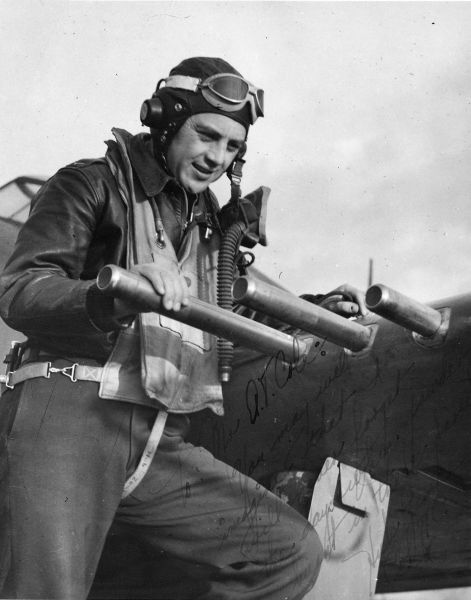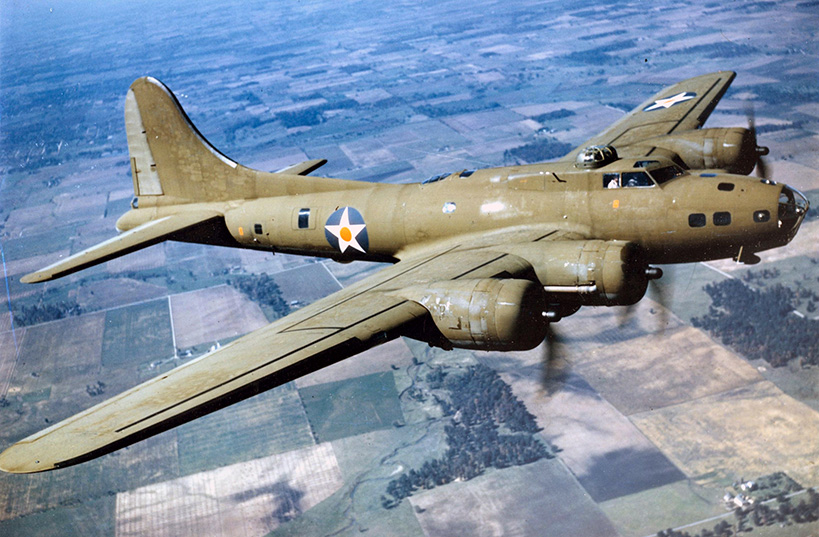Zemke, Hubert A. "Hub"
- Date of birth:
- March 14th, 1914 (Missoula/Montana, United States)
- Date of death:
- August 30th, 1994 (Oroville/California, United States)
- Service number:
- 0-22353.
- Nationality:
- American
Biography
Hubert A. Zemke was born March 14th, 1914, the son of the German immigrants Anna and Benno Zemke. Initially he studied forestry at Montana State University. In 1936 he applied for a job in the U.S. Army Air Corps and was accepted. After his training, he ended up on Randolph Field. Subsequently, Zemke took up fighter training on Kelly Field in Texas. In 1937 he was posted to 37th Pursuit Squadron on Langley Field, Virginia, as a fighter pilot, flying the Curtiss P-40.
In 1940 he was sent to England as an observer to study tactics of the RAF and the Luftwaffe and in 1941 he left for the Soviet Union to train pilots to fly the P-40. He returned to the US in 1942 and on December 16th, 1942, he was named commander of 56th Fighter Group, equiped with the Republic P-47 in the rank of Major. He left for England with his unit in January 1943. October 4th, 1943, he scored his 5th victory, making him an ace. Later on, he was sent back to the US, becoming member of a team led by Brigadeer General Curtiss LeMay to brief Congress and the Pentagon. January 1944, he returned to his unit. During his stay with the 56th, he claimed 15.25 victories.
August 12th, 1944, he was transferred to 479th Fighter Group, equiped with the North-american P-51 Mustang as commanding officer. With this unit he scored another 2.5 victories. October 30th, 1944 he was hit, was forced to bail out and subsequently taken prisoner. At the time he had 17.75 victories in 154 sorties to his credit. On December 16th, 1944, he became Senior Commander in the PoW camp Stalag Luft I. Prior to a possible liberation by Allied troops and in order to prevent the Germans from killing prisoners, he secretly set up a commando unit in the camp, hiding weapons in concealed places. At the approach of Soviet troops, he managed to persuade the Germans to leave and pass command to him. When the Soviets arrived he saw to it that the prisoners were flown to American occupied territory by B-17’s, Operation Revival.
After the war he served as Tactics Division Chief at the Air Tactical School on Tyndall AFB in Florida. During the now famous Berlin Air Lift, he was in command of 36th Fightergroup on Fürstenfeldbruck Air Base near Munich. Later he served as Chief of Staff, 2nd Air Division in Landsberg. In 1953 he studied at the Air War College and afterwards became Chief of Plans in the Directorate of Operations in the Pentagon.
In 1955 he was given command of the 31st Strategic Fighter Wing and the 40th Air Division on Turner AFB, Georgia. From March 1957 onwards he was in command of the Strategic Reconnaissance Wing, likewise on Turner AFB. For three years he served as Air Section Chief, U.S. Military Assistance Advisory Group, in Madrid, Spain, until October 1962 he was given command over the Reno Air Defense Sector on Stead AFB, Nevada. He was discharged in 1966.
After his discharge he worked in agriculture. Hubert Zemnke passed away on August 30th, 1994 in Oroville, California.
Promotions:
May 8th, 1943,: Colonel
Career:
August 30th/31st, 1942: Commanding Officer 89th Flying Training Squadron (AETC);
September 1st, 1942 - October 30th, 1943: Commanding Officer 56th Fighter Group;
January 19th, 1944 - August 12th, 1944: Commanding Officer 56th Fighter Group;
August 12th, 1944: Commanding Officer 479th Fighter Group;
August 1955 - OCtober 1955: Commanding Officer 31st Strategic Fighter Wing;
1955: Commanding Officer 40th Air Division;
March 1957: Commanding Officer 4080th Strategic Reconnaissance Wing;
?: Air Section Chief, U.S. Military Advisory Group, Madrid;
October 1962: Commanding Officer Reno Air Defence Sector, Staed AFB, Nevada.
1966: discharge.
Do you have more information about this person? Inform us!
- Period:
- Second World War (1939-1945)
- Awarded on:
- 1937
- Period:
- Second World War (1939-1945)
- Rank:
- Colonel
- Unit:
- 56th Fighter Group, 8th Air Force (56th Fighter Group, 8th Air Force)
- Awarded on:
- July 6th, 1943
"For gallantry in action against an armed enemy while serving as Pilot of a P-47 Fighter Airplane in the 56th Fighter Group, EIGHTH Air Force, while leading the 56th Fighter Group on twenty-five combat missions over enemy occupied Europe, from 3 April 1943 through 31 May 1943. Colonel Zemke's brilliant leadership, courage, and skill, and the vigorousness of his attacks upon the enemy set an inspiring example for all members of his command. Fervently seeking out the enemy on all occasions, Colonel Zemke has destroyed two enemy airplanes in aerial combat and has inflicted severe damage on two others. The courage, skill and leadership displayed by Colonel Zemke on each of his missions reflect the highest credit upon himself and the Armed Forces of the United States."
General Orders No. 93, Headquarters 8th Air Force (July 6, 1943).
- Period:
- Second World War (1939-1945)
- Rank:
- Colonel
- Unit:
- 56th Fighter Group, 8th Air Force (56th Fighter Group, 8th Air Force)
- Awarded on:
- March 20th, 1944
"For extraordinary heroism in connection with military operations against an armed enemy while serving as Pilot of a P-47 Fighter Airplane in the 56th Fighter Group, EIGHTH Air Force, in aerial combat against enemy forces on 11 February 1944, in the European Theater of Operations. On that date, Colonel Zemke attacked a German airdrome, flying into the face of persistent, heavy and accurate defensive fire. He destroyed one enemy aircraft, damaged two others, damaged two airplane hangers and other buildings in the airdrome. Displaying this same cool, calculated courage on 6 March 1944, he attacked a large formation of airborne German fighter aircraft, delivering his attack so skillfully, and with such tenacity of purpose, without thought of personal safety, as to destroy two and probably destroy one other of the enemy's airplanes. Colonel Zemke's courage, coolness and determination greatly contributed to the successes of aerial operations against the enemy and reflect great credit upon himself and the Armed Forces of the United States."
General Order No. 18, Headquarters U.S. Strategic Forces in Europe (March 20, 1944).
Sources
- Photo 1: Bill Gonyo
- - Military Times Hall of Valor






